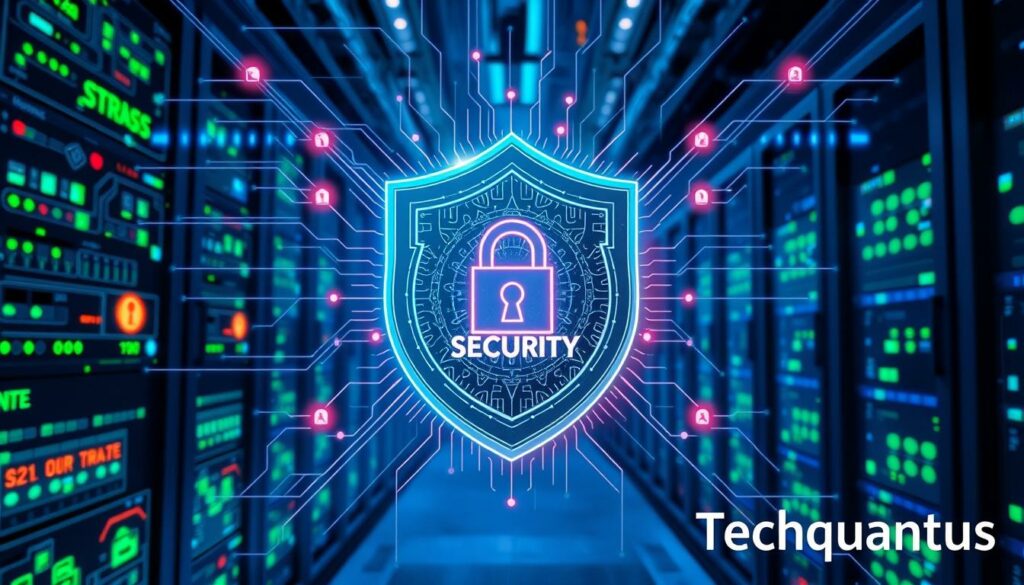Did you know the Defense Innovation Unit talks with 4,000 to 5,000 companies yearly? They give these companies key cybersecurity and AI tools. With threats growing, old security ways don’t cut it anymore. That’s where Zero Trust comes in, a vital way to keep your data safe.
Zero Trust says threats can come from anywhere, inside or outside the network. So, it’s crucial for companies to have strong access controls and watch activity closely. With cyber threats on the rise, knowing this strategy is key. It helps protect your data protection and supports a smooth digital transformation. Using Zero Trust strengthens your defense and meets new rules and tech, boosting your IT security.
Key Takeaways
- Zero Trust Security is key because cyber threats are getting more complex.
- Old security methods don’t work well in today’s digital world.
- Continuous monitoring and strict access controls are key to Zero Trust.
- Rules are pushing for Zero Trust frameworks.
- Adding Zero Trust can greatly improve your IT security.
Understanding Zero Trust Security
Today, embracing the Zero Trust model is key in cybersecurity. It’s all about “never trust, always verify.” Every time someone wants access, they must go through strict checks. This makes it hard for threats to get in.
Definition and Principles
The Zero Trust model is built on important cybersecurity ideas. It checks user identities, device health, and behavior. This way, every access is carefully checked, reducing risks.
It uses multi-layered security to stop unauthorized access. This proactive approach helps manage risks better.
The Evolution of Security Models
Old security methods, like perimeter defenses, don’t work well against new threats. With more tech and cloud use, we need a better approach. Zero Trust is this new strategy, adapting to threats.
Many businesses worry if they’ve been hacked. Zero Trust helps by controlling access tightly. This ensures they can handle new security challenges well.
Advances in cybersecurity show we must adapt to Zero Trust. It’s vital for protecting against many cyber threats. Zero Trust helps keep businesses safe and resilient.
The financial sector has seen more ransomware attacks. This shows the need for better cybersecurity strategies. Zero Trust is key to meeting these needs.
Understanding Zero Trust security is crucial for better defense. For more on how cybersecurity companies are doing, check out the Zscaler report here.
The Importance of Cybersecurity Today
The world of cybersecurity is changing fast, bringing big challenges for businesses in many fields. With more cyber threats, companies need strong plans to protect their important data. Things like advanced threats, malware, ransomware, and social engineering attacks make it crucial to have good cybersecurity.
Knowing about the threats helps you get ready for what might happen. This way, you can take steps to keep your data safe.
Current Threat Landscape
Data breaches are happening more often, showing how vital cybersecurity is. Many organizations face a data breach every year, leading to big financial losses and damage to their reputation. For example, the food and agriculture sector in the U.S. faced over 167 ransomware attacks last year.
This shows how vulnerable it is to cyber threats. The USDA’s Office of Homeland Security has a small budget and few people. So, it’s important to think about how to use resources better to fight cyberattacks.
Data Breaches and Their Impact
Data breaches have big effects, hurting trust in companies and their reliability. They cause financial losses and damage to a company’s reputation. The impact of cybersecurity on keeping things running smoothly means companies must focus on security.
Recently, lawmakers have pushed for better cybersecurity in the food and agriculture sector. They introduced the Farm and Food Cybersecurity Act. This shows they understand the need to tackle these threats early.
Key Components of Zero Trust Security
Zero Trust Security relies on key elements to keep data and systems safe. Identity and access management (IAM) systems are crucial. They make sure only verified users can see sensitive info. This builds trust by always checking who has access.
Identity and Access Management
Checking who you are is key in IAM. Using more than one way to prove your identity and strict rules for access helps stop unauthorized users. This keeps your network safe by checking who is on it all the time.
Micro-Segmentation Techniques
Micro-segmentation is a strong way to boost security. It breaks your network into smaller, safe areas. This stops attackers from moving freely. It also protects important data and helps follow the rules. Using micro-segmentation can help meet your security goals and make your network safer.
Continuous Monitoring and Validation
Watching your systems closely is crucial to catch and stop threats fast. You need tools that check what’s happening and spot strange activities. This lets you act quickly if there’s a problem. Following strict watch rules makes your security strong.
| Key Component | Description | Benefits |
|---|---|---|
| Identity and Access Management | Ensures only authenticated users can access data. | Reduces unauthorized access, builds trust. |
| Micro-Segmentation | Divides networks into smaller isolated segments. | Limits lateral movement, enhances compliance. |
| Continuous Monitoring | Real-time analysis of activities for anomalies. | Enables swift responses to potential breaches. |
Using these parts shows how important it is to keep up with security changes. Success comes from knowing how identity checks, breaking up networks, and always watching improve security. Learn more about security by visiting security best practices.
How Zero Trust Enhances IT Security
Zero Trust changes how we handle access and respond to incidents in IT security. It focuses on giving users only what they need to do their jobs. This approach greatly reduces the risk of insider threats and misuse, making security better overall.
Implementing Least Privilege Access
Least privilege access limits what users can do. It keeps sensitive data safe while still letting things run smoothly. With this, companies can keep a close eye on who has access, thanks to Zero Trust updates like Cloudflare’s move and Palo Alto Networks’ new features. These changes show how important it is to control access well for strong security.
Improving Incident Response Protocols
Improving how we handle security incidents is key in Zero Trust. Being able to quickly spot and stop security issues comes from always watching the network. The NIST highlights the need for access control based on policies as a key part of handling incidents well. Companies using Zero Trust can act fast to lessen damage from cyberattacks, making them more resilient.
For more info on the Zero Trust Network Access market, check out this market overview. The market is expected to grow by 14.88% from 2024 to 2031. This shows how more companies are turning to these important security tools for safer work environments.
Real-World Applications of Zero Trust Security
Companies from various sectors are turning to Zero Trust adoption as cyber threats grow more complex. This method helps protect against advanced attacks, especially in sectors dealing with sensitive data.
Case Studies in Various Industries
The Department of Defense has made big strides in using Zero Trust. Their efforts show how Zero Trust is key to fighting modern cyber threats. Industry case studies show how well this approach works:
| Industry | Adoption Example | Benefits Realized |
|---|---|---|
| Healthcare | Hospitals implementing stringent identity verification | Increased patient data protection and compliance with regulations |
| Finance | Banking institutions utilizing micro-segmentation | Improved fraud detection and prevention |
| Government | Defense agencies leveraging AI-driven threat intelligence | Enhanced operational efficiency and reduced cyber risks |
How Organizations are Adopting the Model
Switching to Zero Trust needs a careful plan. Companies are focusing on cybersecurity applications that protect identities and key assets. Case studies show the importance of unique identity checks. The FBI suggests that firms should have specific plans to fight threats from skilled hackers. Training staff to spot and handle threats is key. You can learn more about this at this link.
Challenges in Implementing Zero Trust Security
Organizations face big challenges when trying to use Zero Trust Security fully. It’s key to tackle these issues to move to a safer digital world. The main problems are resistance to change and the need for more resources for training.
Resistance to Change within Organizations
Many people in organizations don’t want to switch to Zero Trust Security. They might feel scared of new rules and tech. This fear comes from not understanding why these changes are needed or worrying about losing their jobs.
To overcome this, it’s important to talk openly and clearly about the benefits. Leaders should make sure everyone knows how Zero Trust makes things safer. Getting team members involved in the change helps a lot.
Resource Allocation and Training Needs
Getting enough resources for Zero Trust is crucial. Companies need to spend on new tech and skilled people. Training isn’t just for new hires; it’s ongoing to keep up with security updates.
Having a clear plan for training helps everyone feel ready for new security steps. CISA says making an asset inventory helps see what you have and where to spend resources wisely.

| Implementation Challenges | Impact on Organizations | Strategies for Overcoming |
|---|---|---|
| Organizational Resistance | Delayed adoption of security measures | Effective communication and training |
| Resource Allocation | Lack of technological tools | Budgeting for necessary investments |
| Training Requirements | Unprepared staff for new systems | Ongoing education initiatives |
Future Trends in Cybersecurity and Zero Trust
The world of cybersecurity is changing fast, thanks to new tech and more rules. Using Zero Trust is key for companies today. It makes security better and fits well with AI, cloud use, and following the law.
The Role of Artificial Intelligence
AI is crucial in fighting cyber threats early. It uses machine learning to look through lots of data for unusual patterns. This helps companies act fast if there’s a possible attack, making them safer.
Integration with Cloud Services
More companies are moving to the cloud, so using Zero Trust with cloud services is vital. It’s not just about keeping data safe. It’s also about making sure people can access cloud services safely. Zero Trust helps protect important info while using cloud benefits.
Growing Regulatory Compliance Demands
More laws about keeping data private are coming, putting pressure on companies. Using Zero Trust in cybersecurity is key to follow these laws and protect customer info. Having strong rules and following them helps companies stay on the right side of the law.
Best Practices for Implementing Zero Trust Security
Implementing Zero Trust security needs a clear plan. Using Zero Trust best practices helps make your organization secure. By focusing on key areas, you can protect your data from new threats.
Steps for a Successful Transition
To move to a Zero Trust model, follow these steps:
- Do a deep check of your current security setup to see what’s good and what’s not.
- Keep teaching users about security and build a security-aware culture in your company.
- Use micro-segmentation to divide your networks.
- Add multi-factor authentication (MFA) to make sure users are who they say they are.
- Keep systems updated to fix security holes.
Key Technologies to Consider
Here are some tech tools that can boost your Zero Trust plan:
- Strong identity management solutions to check users everywhere.
- Endpoint security tools to keep devices safe and let users in easily.
- Advanced monitoring systems to watch user actions and spot odd behavior.
- Cloud security products to keep data safe in the cloud.

| Technology | Purpose | Benefits |
|---|---|---|
| Identity Management Solutions | Verify users and manage access | Enhanced security and improved compliance |
| Endpoint Security Tools | Protect devices from threats | Reduced risk of data breaches |
| Monitoring Systems | Continuous assessment of user behavior | Real-time threat detection |
| Cloud Security Products | Secure data within cloud environments | Protection against data loss and leakage |
Conclusion
Zero Trust Security is key for dealing with today’s complex cyber threats. It’s vital to use a Zero Trust approach as cyber threats get more advanced. This method helps protect your organization and keep sensitive info safe.
Understanding Zero Trust is crucial for strong IT security. Companies that use these strategies are ready for new challenges. With new tech and more rules, Zero Trust Security is a must for staying safe.
The future of IT security depends on using Zero Trust well. Focus on managing identities, always checking for threats, and being proactive. Also, use tech that helps send emails better, like in this comprehensive resource. A smart security plan will help your company do well, even when things are uncertain.
FAQ
What is Zero Trust Security?
Zero Trust Security is a top-notch cybersecurity plan. It uses strict access controls. It says “never trust, always verify.” It thinks threats can come from inside or outside an organization. So, it checks user identity, device health, and behavior all the time.
Why is Zero Trust important in today’s cybersecurity landscape?
Old-school security measures don’t cut it anymore with today’s cyber threats. Zero Trust helps keep data safe and supports digital changes. It’s key for fighting off data breaches and cyber attacks.
What are the key components of Zero Trust Security?
Key parts of Zero Trust Security are strong Identity and Access Management (IAM) systems. It also uses micro-segmentation to limit network movement. And, it’s all about continuous monitoring and validation to catch and act on odd behaviors right away.
How does Zero Trust enhance IT security?
Zero Trust makes IT security better by giving users only what they need for their jobs. This lowers the risk of insider threats and misuse of data. It also makes handling security issues faster.
What are some real-world examples of Zero Trust implementation?
Many groups, like the Department of Defense, use Zero Trust in their cybersecurity plans. Finance and healthcare sectors also share how they’ve made the switch to Zero Trust. This helps protect data and follow the rules.
What challenges do organizations face when implementing Zero Trust?
Organizations face challenges like getting employees to accept new systems and needing enough resources and training. Success comes from good communication and investing in the right tech and training for staff.
What trends are shaping the future of Zero Trust Security?
The future of Zero Trust Security is linked to AI, which can better detect and handle threats. As companies move to the cloud, Zero Trust is key for protecting data and following rules.
What best practices should organizations follow when implementing Zero Trust Security?
Companies should check their current security setups, teach users well, and build a security-aware culture. It’s also key to invest in strong identity management and monitoring tools to back up the Zero Trust plan.
Source Links
- https://federalnewsnetwork.com/ask-the-cio/2024/09/army-forces-command-diu-filling-ai-knowledge-gaps/
- https://www.govtech.com/workforce/improved-ux-processes-part-of-jeff-clines-legacy-in-s-d
- https://www.bleepingcomputer.com/news/security/ftc-americans-lost-over-110-million-to-bitcoin-atm-scams-in-2023/
- https://www.insurancebusinessmag.com/asia/news/cyber/survey-exposes-cybersecurity-shortfalls-in-southeast-asias-business-landscape-504074.aspx
- https://www.insurancebusinessmag.com/nz/news/cyber/new-zealand-cybersecurity-leaders-push-for-gender-inclusivity-and-equity-504069.aspx
- https://therecord.media/government-is-not-ready-for-food-agriculture-cybersecurity-usda
- https://www.stocktitan.net/news/ZS/zscaler-reports-fourth-quarter-and-fiscal-2024-financial-wix4mqmpan64.html
- https://mycareer.verizon.com/jobs/r-1046178/act-mgr-rtl-smb-business-sls/
- https://www.openpr.com/news/3644285/zero-trust-network-access-market-expansion-current-dynamics
- https://industrialcyber.co/cisa/cisa-unveils-zero-trust-guidance-to-safeguard-connected-communities/
- https://cryptoslate.com/fbi-warns-of-north-korean-threat-to-crypto-cautions-against-potential-etf-related-attacks/
- https://securityboulevard.com/2024/09/columbus-sues-expert-fueling-debate-about-ransomware-attack/
- https://www.theregister.com/2024/09/03/spamouflage_trolls_us_elections/
- https://securityboulevard.com/2024/09/why-ntia-support-of-open-source-ai-is-good-for-security/
- https://www.rtinsights.com/viper-revolutionizing-ai-generated-personalization/
- https://www.marketscreener.com/quote/stock/FIRST-WATCH-RESTAURANT-GR-127579618/news/First-Watch-Names-Rob-Conti-as-Chief-Information-Officer-47794729/
- https://www.energy.gov/em/articles/em-msipp-stars-scholars-shine-conclusion-internship
- https://www.baselinemag.com/business-intelligence/optimizing-email-deliverability-advanced-techniques/
- https://natlawreview.com/article/seventh-circuit-clarifies-parties-rights-jury-trial-when-pursuing-equitable-aiding
- I Learned About AI Mistakes That Could Change Your Life
- Sustainable & Green Energy Solutions for Next‑Gen Data Centers Trend Report
- Learn How to Start a Career in a Data Centre: Skills, Certifications & First Steps
- My Guide to Understanding Data Centre Architecture: Core Components Every IT Pro Should Know
- Wazuh Home Network Setup: A Step-by-Step Guide
Related posts:
 The Rise of Zero Trust: Why It’s the Future of IT Security
The Rise of Zero Trust: Why It’s the Future of IT Security
 The Role of Ethical Hacking in Strengthening Cybersecurity
The Role of Ethical Hacking in Strengthening Cybersecurity
 How to Implement a Zero Trust Security Model in Your Organization
How to Implement a Zero Trust Security Model in Your Organization
 Access Control Concepts: Safeguarding Systems and Data in Cybersecurity
Access Control Concepts: Safeguarding Systems and Data in Cybersecurity
 Cybersecurity in the Cloud: Best Practices for Keeping Data Safe
Cybersecurity in the Cloud: Best Practices for Keeping Data Safe
 CISSP Domain 2: Guide to Asset Security Fundamentals
CISSP Domain 2: Guide to Asset Security Fundamentals
